Technology is constantly evolving and at a much faster pace than anyone could have anticipated a few decades ago. Telecommunication industry is no different and, with 4G and its capabilities, it has already proven that. Read on to understand what open radio access network (RAN) brings to the table as the world welcomes 5G.
It all started with the analogue phones when signals were not digital. 2G introduced digital voice calls along with several facilities, such as text messaging and other data services, although speed was still a major issue. A leap was made with the introduction of 3G as smartphones came into existence with a significant improvement in the speed of the network itself.
As 4G came along, it brought with it a very high speed network with anywhere between 2 to 10MBps (megabytes per second). It allowed multiple devices to connect to a single network. The next big leap being taken is of 5G, with which the speed is going to be even higher. It can vary anywhere between 100 and 200MBps for downloading. It will have the lowest latency rate of about one millisecond, which is far lower than 4G’s. It will improve real-time communications tremendously.
What 5G has to offer
There are essentially three aspects that 5G will be assisting with the most:
Enhanced mobile broadband. The applications for augmented reality, where a good internet speed is required with a low latency, will be a lot more feasible. The uniformity of the connection will be maintained, hence ensuring that your experience is seamless.
Mission-critical services. Self-driving cars require real-time connection with the servers, which can be possible with 5G. A real-time connection also helps in making a better decision and much more access, especially in the robotics sector. In healthcare sector, 5G can make it easier to conduct medical procedures remotely due to its ultra-low latency and strong security.
Internet of Things (IoT) devices. A lot of IoT devices demand good connectivity to function properly and provide users with a hassle-free experience, which can easily be taken care of with 5G. It will improve their overall coverage at a very affordable cost.
How the mobile network works
Mobile devices are kind of IoT devices. All mobile devices are connected to various cell towers that are known as base stations. A group of such towers forms a radio access network and remains connected to the core network.
The core network is responsible for client profiling. It provides access to various services, such as subscriber trunk dialing (STD) calls and data services. Signals from the towers are sent to the core network and the core network is responsible for all the further tasks, such as the execution of the final service. It can be any kind of service, such as an internet connection. The core network, thus, acts as a gateway between the radio access network and the final services (see Fig. 1).
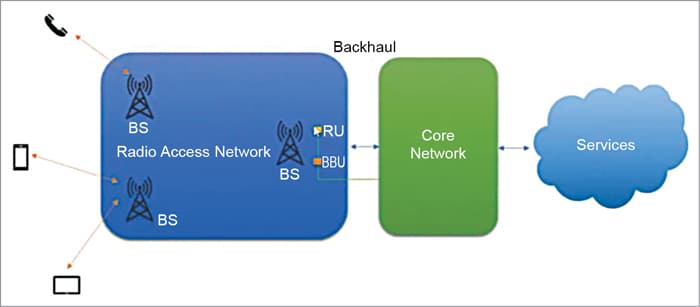
Traditional vs open RAN
Before the introduction of 5G, the base station had mainly two units—the radio unit (RU) or the signal transmitting unit and the baseband unit (BBU) for processing of the signals. RU receives the signals and sends to BBU. Only after that the signals are sent to the core network.
Earlier on, a single vendor used to provide all the units and the connection between them was also deployed by that vendor only. There used to be a very tightly coupled system, which made it hard to change any component. We use software to run the hardware, but earlier on that software was very tightly integrated inside the hardware, which presented a challenge to change the software as well.
So, it was difficult to upgrade the infrastructure besides full dependency on a single vendor. If one wanted to shift to a different vendor, the entire hardware and the software had to be changed, which was never convenient.
Open RAN (O-RAN) makes both hardware and software follow a set of rules so that any vendor can come up with their own solutions. It allows hardware and software from different vendors to work together.
Servers can now independently implement virtualisation due to this desegregation. You do not need a physical server for the mandate. O-RAN even makes cloud solutions possible. It lets one virtualised baseband unit support multiple radios instead of needing a proprietary or a physical unit at every cell site. It is much more flexible and cost-effective at the same time.
Benefits of open O-RAN
Hardware and software disaggregation. The hardware and the software are independent of each other.
Intelligence and automation. It makes open management and orchestration more feasible, since everything is quite open and there are standard rules to do things. It uses external artificial intelligence and machine learning capabilities.
Open internal RAN interfaces. O-RAN lowers layer split, which basically splits the previous single unit to multiple units and mobilises them and makes a multi-vendor solution.
Rapid innovation. It has improved the innovation pace significantly due to the increased competition among the vendors themselves. Newer companies are now coming up with their own components which tend to work a lot better.
Architecture of a typical mobile network
As shown in Fig. 2, the core network and the access network are connected by the transport network, which is also known as the backhaul network. Then there is an air interface that connects a user with the service provider’s network. There are various other services that run on top of the core network. The core network and the access network contain both the hardware and software that can be seen at the left in Fig. 2.
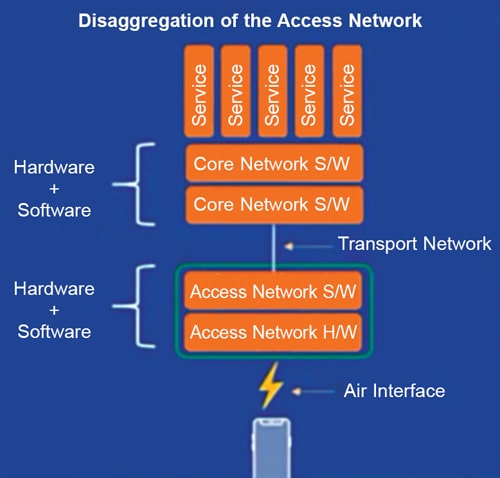
For proper understanding of the architecture let us understand a few things from previous-generation network architectures first.
All the electronics were in one or more cabinets at the bottom of a mast (tower) when 2G and 3G were in use. The RF cables would run to the antennas on top of the mast. The RF signal continuation in the RF cable was a big problem because of the congestion that used to occur.
As a result, the later phases of 3G entering 4G allowed the industry to take a different approach that worked better. Instead of sending RF signals from the cabinet to the antennas, the RF signals were moved closer to the antennas (as can be seen in Fig. 3). This ensured that there was a very minimal loss of signals. This new piece of electronics is known as remote radio unit (RRU) or remote radio head (RRH). At the bottom we had the base band unit.
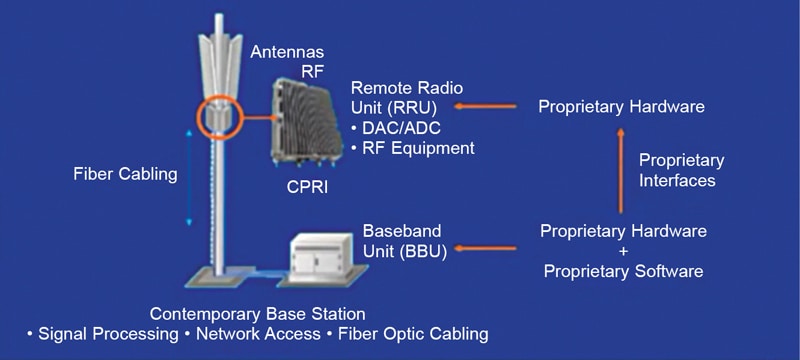
Let us move to the cabinet next. A cabinet consists of both the hardware as well as the software. RRU is always a proprietary hardware whereas BBU is a proprietary software along with the interfaces between BBU and RRU.
O-RAN has following components:
Baseband unit (BBU) in telecom systems that transports a baseband frequency, usually from a remote radio unit, to which it may be tied through optical fibre.
Remote radio unit (RRU), which is the distributed and integrated frequency unit that connects to an operator’s network with the user equipment like cell phone and mobile devices.
Radio frequency (RF) band, a frequency band that is used for communication transmissions and broadcasting.
Common public radio interface (CPRI), a popular standard for transporting baseband signals to radio units. It is an interface between radio equipment control (REC) and radio equipment (RE).
Understanding the O-RAN architecture
With the O-RAN approach, the RRU is now commercial off-the-shelf (COTS) based hardware that can be purchased from any original design manufacturer (ODM) or original equipment manufacturer (OEM) or RAN hardware vendor. The BBU is proprietary software with virtualised functions running on a COTS server.
It is important to note that the interface between BBU and RRU is an open interface, which is an open functionality that we can see here (see Fig. 4). This would allow any vendor’s software to work with any other vendor’s hardware and vice versa.
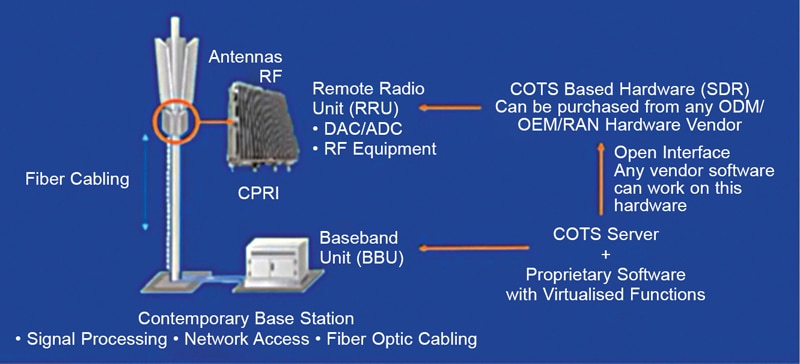
Opportunities and challenges of O-RAN
There are quite a few opportunities offered by O-RAN, some of which are:
Avoid vendor lock-in
With the fully interoperable and desegregated RAN, the service provider should be able to choose from the best in class RAN component manufacturers. This results in a mixture of vendors within the RAN
Spur innovation
When functionality is 100%, further enhancement to the software can be done proficiently.
Hardware-software development
5G creates new monetisation opportunities.
Telecommunication experts expect their partners to offer 5G on both hardware and software front. Hence, more opportunities can be found in this area as well.
However, there are some challenges faced in the use of O-RAN as well, which cannot be ignored. The two most important challenges to take note of are:
Security
Network security is one of the major challenges as different vendors follow different security protocols.
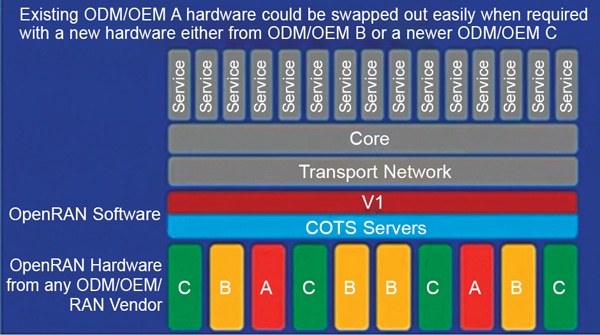
Openness
Since it is open sourced, it is susceptible to threats.
5G has evolved and is still evolving at a much higher pace. Mobile network operators are benefited tremendously with O-RAN standards. More new features will be introduced to it eventually that will make it even more economical and will improve the hardware and software integration. With this context as a user, you shall be able to make an informed decision for yourself.
This article has been put together from a tech talk session at OSI 2021 by Binitha MT – Dell Technologies, Subhankar Adak – Dell EMC, and Krutika Dhanakshirur – Dell EMC and has been transcribed and curated by EFY’s Laveesh Kocher, a tech enthusiast with a knack for open source exploration and research.






